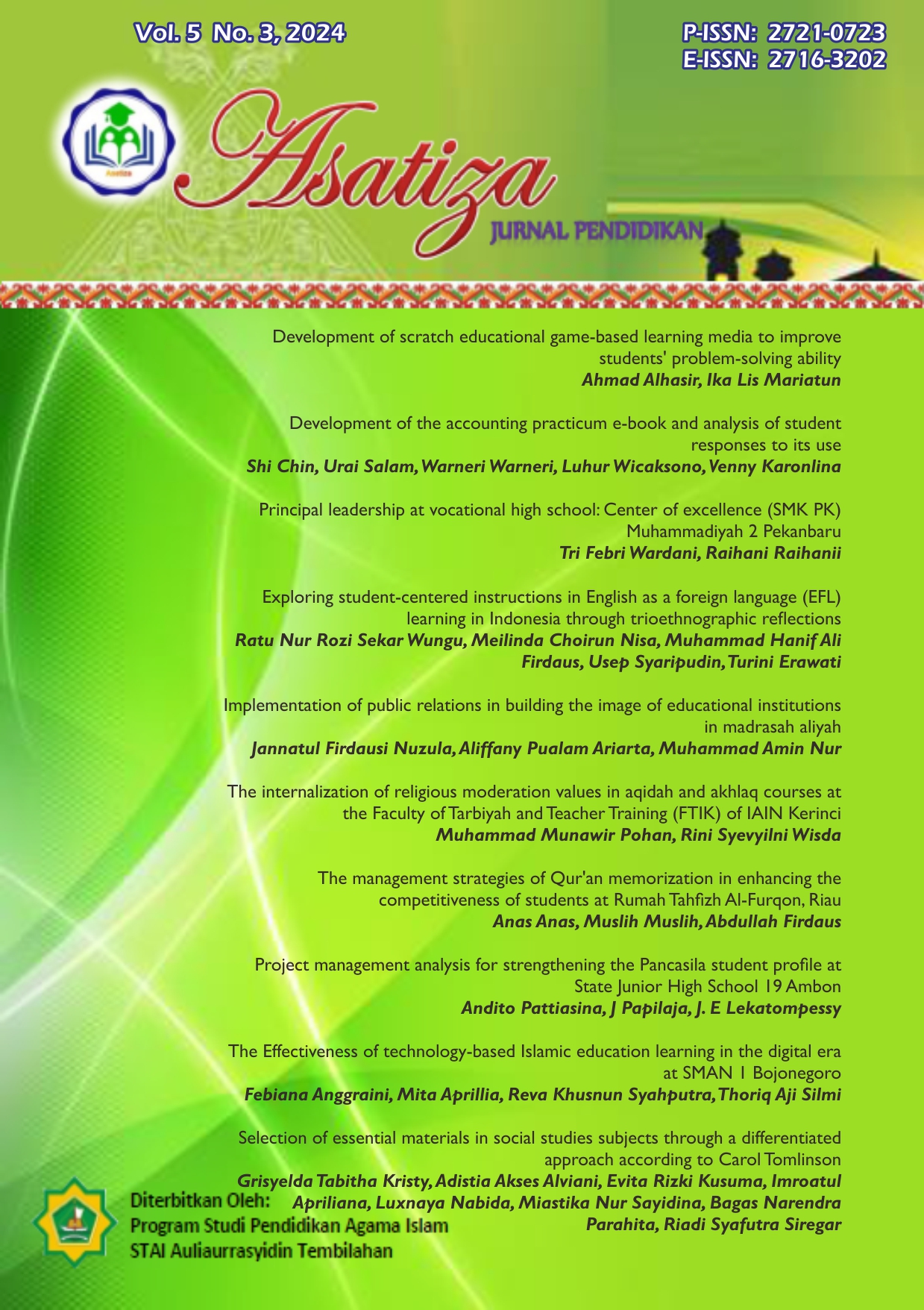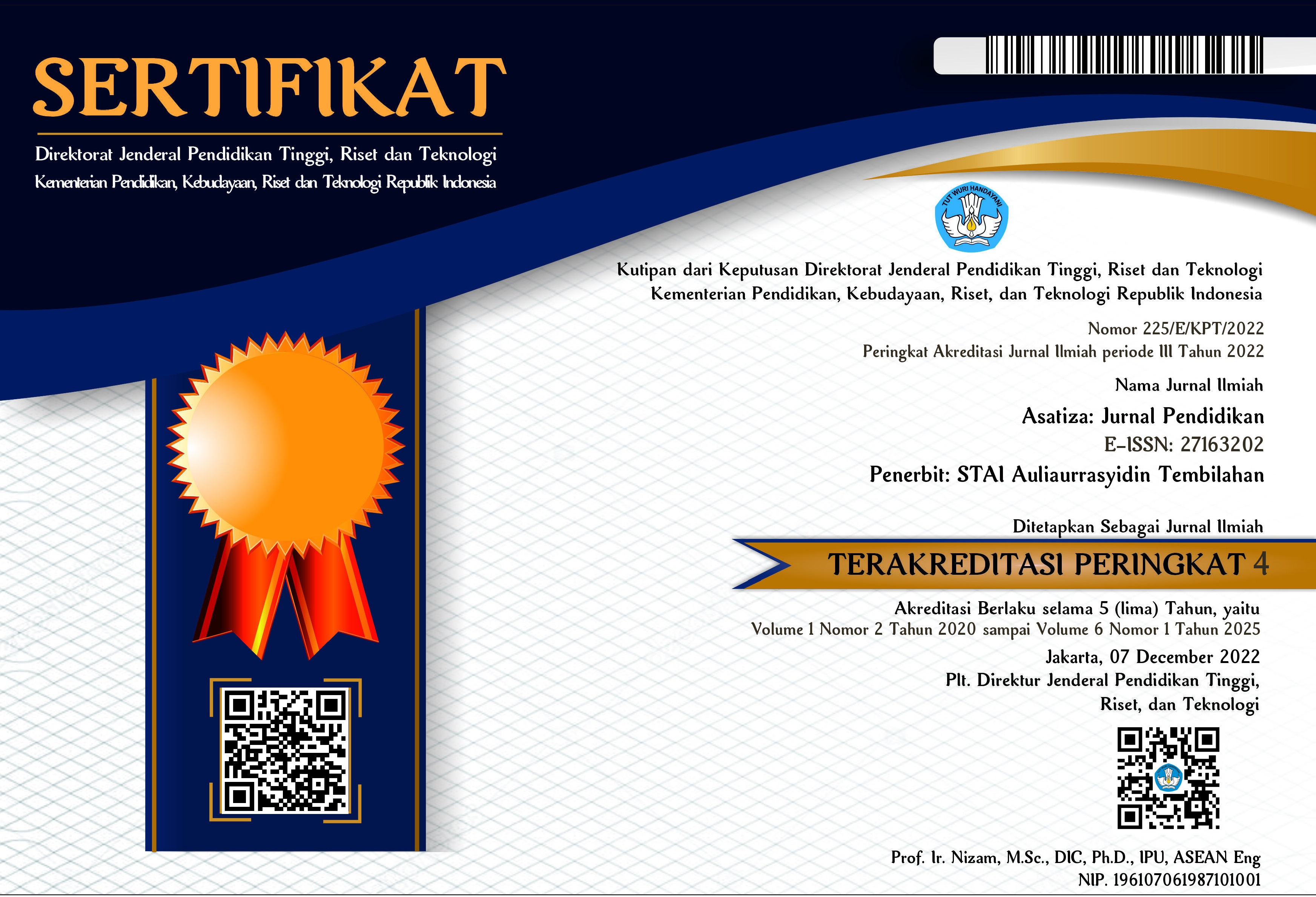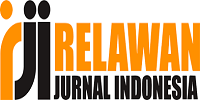Exploring student-centered instructions in English as a foreign language (EFL) learning in Indonesia through trioethnographic reflections
DOI:
https://doi.org/10.46963/asatiza.v5i3.1885Keywords:
Trioethnographic, Student-Centered Instructions, EFL learningAbstract
This article examines professional development through the lens of trioethnographic reflections to enhance student-centered teaching practices. Trioethnography, derived from duoethnography, is a qualitative research method where two or more researchers engage in reflective dialogue to explore an issue. We collected data through four reflective conversations, guided by faculty advisors, during our teaching practicum. Our analysis identified three key themes from these dialogues: (1) reexamining our beliefs about student-centered instruction, (2) recognizing sociocultural barriers to this approach, and (3) sharing experiences of relearning teaching methods. These conversations created a safe space to exchange insights and collaboratively build understanding. The findings have significant implications for teachers and teacher education. First, teachers must continually reassess the beliefs and assumptions that underpin their teaching. Second, understanding students more deeply is crucial for effectively implementing student-centered teaching, especially in EFL contexts. Third, preservice teacher education should emphasize the importance of self-reflection and critical examination of teaching beliefs, fostering both personal and professional growth. Lastly, future research should narrow its focus on specific practical issues within student-centered EFL teaching to further enrich the field and improve teaching practices. Collaborative reflection should become a routine part of teacher education programs to better prepare future educators.
Downloads
References
Afshar, H. S., & Farahani, M. (2018). Inhibitors to EFL teachers’ reflective teaching and EFL learners’ reflective thinking and the role of teaching experience and academic degree in reflection perception. Reflective Practice, 19(1), 46-67. https://doi.org/10.1080/14623943.2017.1351353
Bjork, C. (2013). Teacher training, school norms and teacher effectiveness in Indonesia. In D. Suryadarma & G. W. Jones (Eds.), Education in Indonesia, 53–67. Institute of Southeast Asian Studies.
Dardjowidjojo, S. (2006). The implementation of Western approaches in eastern societies. Indonesian Journal of English Language Teaching, 2(1), 1–20. https://doi.org/10.25170/ijelt.v2i1.1429
Dornyei, Z., & Ushioda, E. (2011). Teaching and Researching Motivation. In PEARSON Education Inc (2nd ed.). Longman.
Faghihi, G., & Sarab, M. R. A. (2016). Teachers as reflective practitioners: A survey on Iranian English teachers’ reflective practice. The Journal of Teaching Language Skills (JTLS), 7(4), 57 86. https://doi.org/10.22099/jtls.2016.3659
Lowe, R. J., & Lawrence, L. (Eds.). (2020). Duoethnography in English Language Teaching: Research, Reflection and Classroom Application. Multilingual Matters
Lowe, R.J., & Kiczkowiak, M. (2016). Native-speakerism and the complexity of personal experience: A duoethnographic study. Cogent Education, 3, 1 – 16. https://doi.org/10.1080/2331186X.2016.1264171
Mathew, P., Mathew, P., & Peechattu, P. J. (2017). Reflective practices: A means to teacher development. Asia Pacific Journal of Contemporary Education and Communication Technology (APJECT), 3(1), 126-131.
Mlecko, J. D. (1982). The Guru in Hindu Tradition. Numen, 29(1), 33. https://doi.org/10.2307/3269931
Moradkhani, S., Raygan, A., & Moein, M. S. (2017). Iranian EFL teachers’ reflective practices and self-efficacy: Exploring possible relationships. System, 65, 1-14. https://doi.org/10.1016/j.system.2016.12.011
Norris, J., Sawyer, R.D., & Lund, D. (Eds.). (2012). Duoethnography: Dialogic Methods for Social, Health, and Educational Research (1st ed.). Routledge. https://doi.org/10.4324/9781315430058
Nurfaidah, S., Lengkanawati, N. S., & Sukyadi, D. (2017). Levels of reflection in EFL pre-service teachers teaching journal. Indonesian Journal of Applied Linguistics, 7(1), 80-92. https://doi.org/10.17509/ijal.v7i1.6861
Pandey, S. R. (2012). Reflective practice: A gateway to professional development. Journal of NELTA, 17(1-2), 40-49. https://doi.org/10.3126/nelta.v17i1-2.8091
Richardson, P. W., & Watt, H. M. G. (2006). Who Chooses Teaching and Why? Profiling Characteristics and Motivations Across Three Australian Universities. Asia-Pacific Journal of Teacher Education, 34(1), 27–56. https://doi.org/10.1080/13598660500480290
Susoy, Z. (2015). Watch your teaching: A reflection strategy for EFL pre-service teachers through video recordings. Procedia - Social and Behavioral Sciences, 199, 163- 171. https://doi.org/10.1016/j.sbspro.2015.07.501
Tiainen, O., Korkeamäki, R., & Dreher, M. J. (2018). Becoming reflective practitioners: A case study of three beginning pre-service teachers. Scandinavian Journal of Educational Research, 62(4), 586-600. https://doi.org/10.1080/00313831.2016.1258673
Widodo, H. P., & Ferdiansyah, S. (2018). Engaging student teachers in video-mediated self-reflection in teaching practice. In K. J. Kennedy & J. C-K. Lee (Eds.), The Routledge handbook of schools and schooling in Asia, 922-934. Routledge.
Yesilbursa, A. (2011). Reflection at the interface of theory and practice: An analysis of pre-service English language teachers’ written reflections. Australian Journal of Teacher Education, 36(3), 50-62. http://dx.doi.org/10.14221/ajte.2011v36n3.5
Downloads
Published
Issue
Section
License
Copyright (c) 2024 Ratu Nur Rozi Sekar Wungu, Meilinda Choirun Nisa, Muhammad Hanif Ali Firdaus, Usep Syaripudin, Turini Erawati

This work is licensed under a Creative Commons Attribution-ShareAlike 4.0 International License.
Authors who publish with this journal agree to the following terms:
1. Copyright on any article is retained by the author(s).
2. The author grants the journal, right of first publication with the work simultaneously licensed under a Creative Commons Attribution shareAlike 4.0 International License that allows others to share the work with an acknowledgment of the work’s authorship and initial publication in this journal.
3. Authors are able to enter into separate, additional contractual arrangements for the non-exclusive distribution of the journal’s published version of the work (e.g., post it to an institutional repository or publish it in a book), with an acknowledgment of its initial publication in this journal.
4. Authors are permitted and encouraged to post their work online (e.g., in institutional repositories or on their website) prior to and during the submission process, as it can lead to productive exchanges, as well as earlier and greater citation of published work.
5. The article and any associated published material is distributed under the Creative Commons Attribution-ShareAlike 4.0 International License











2.png)



